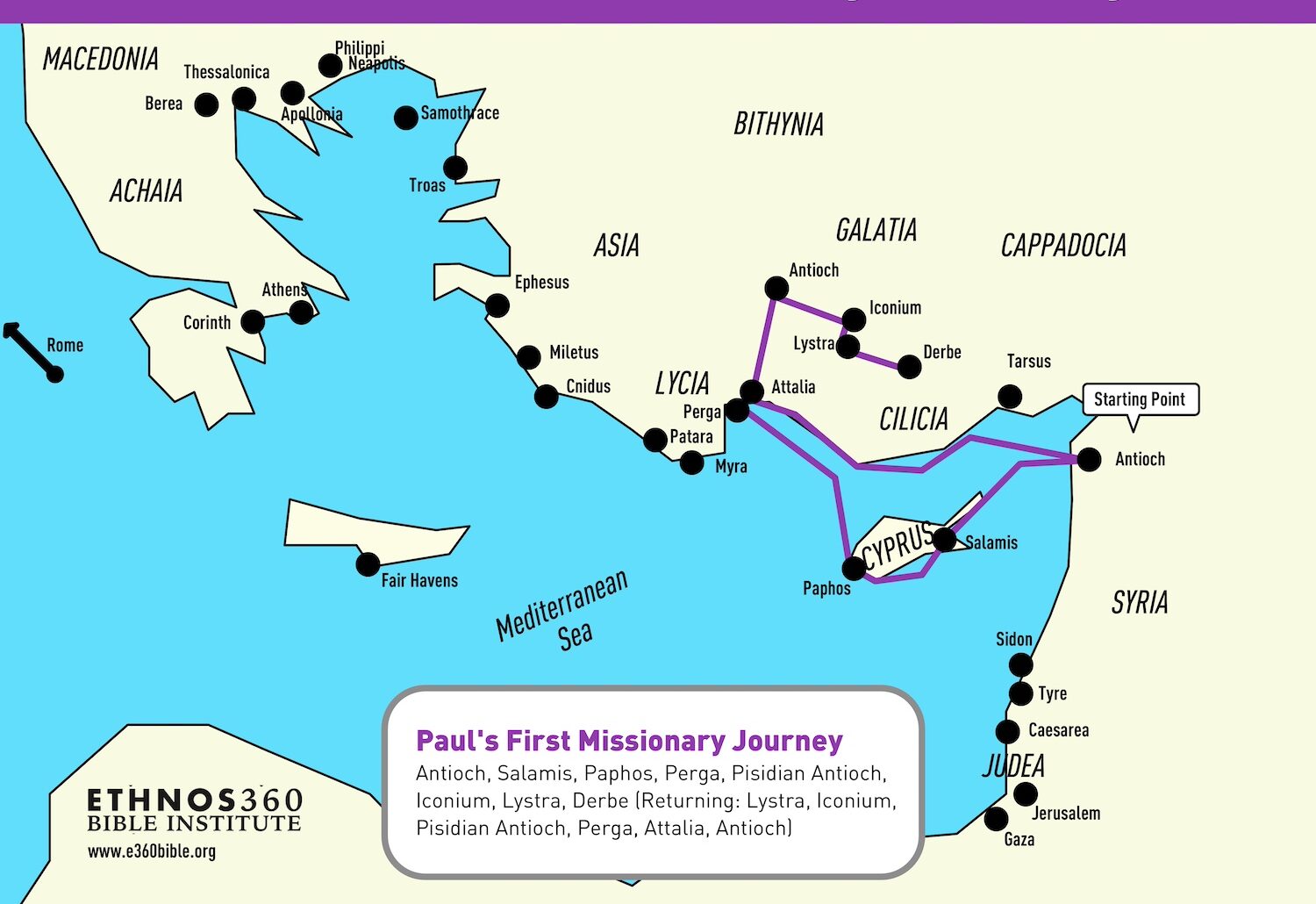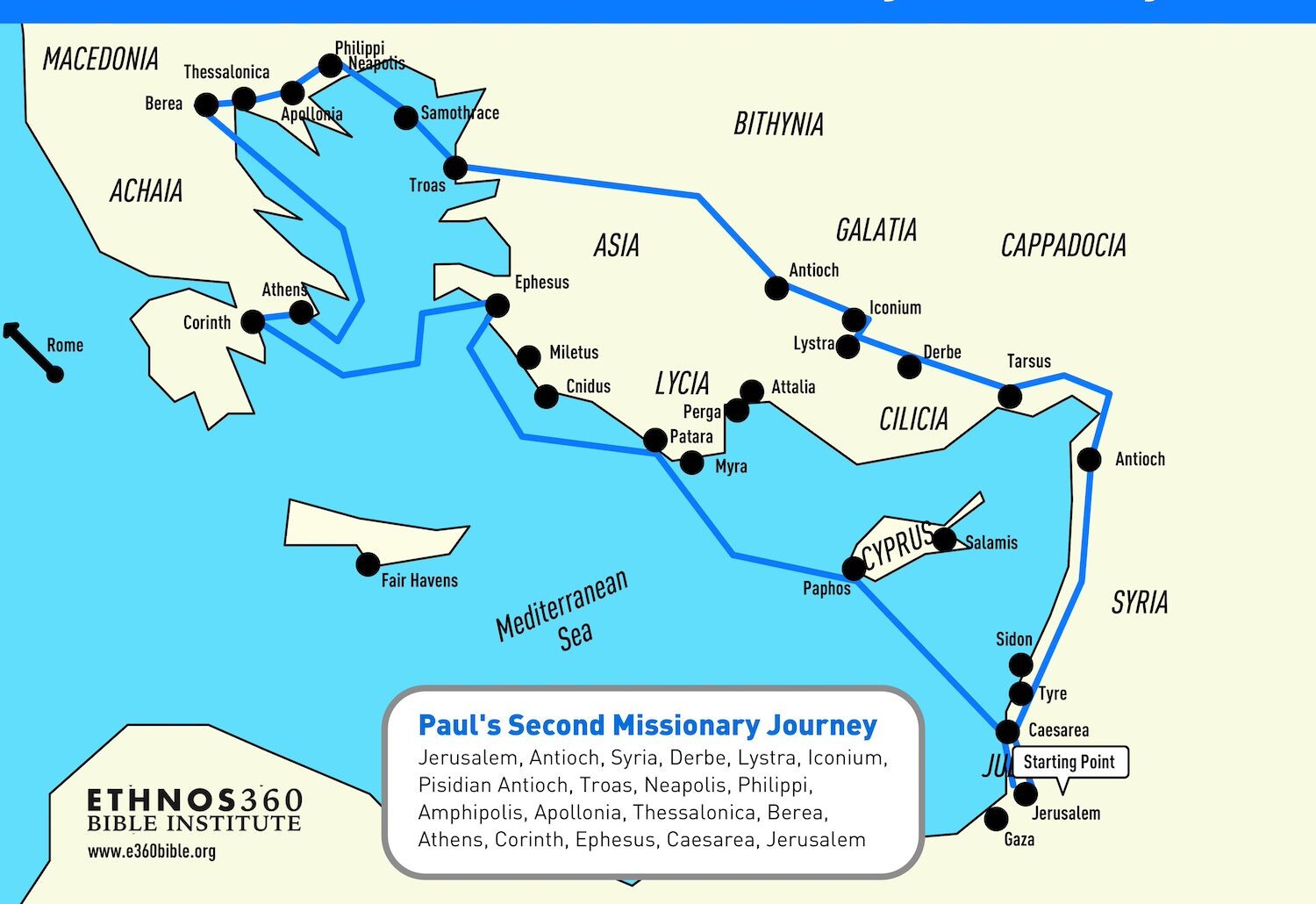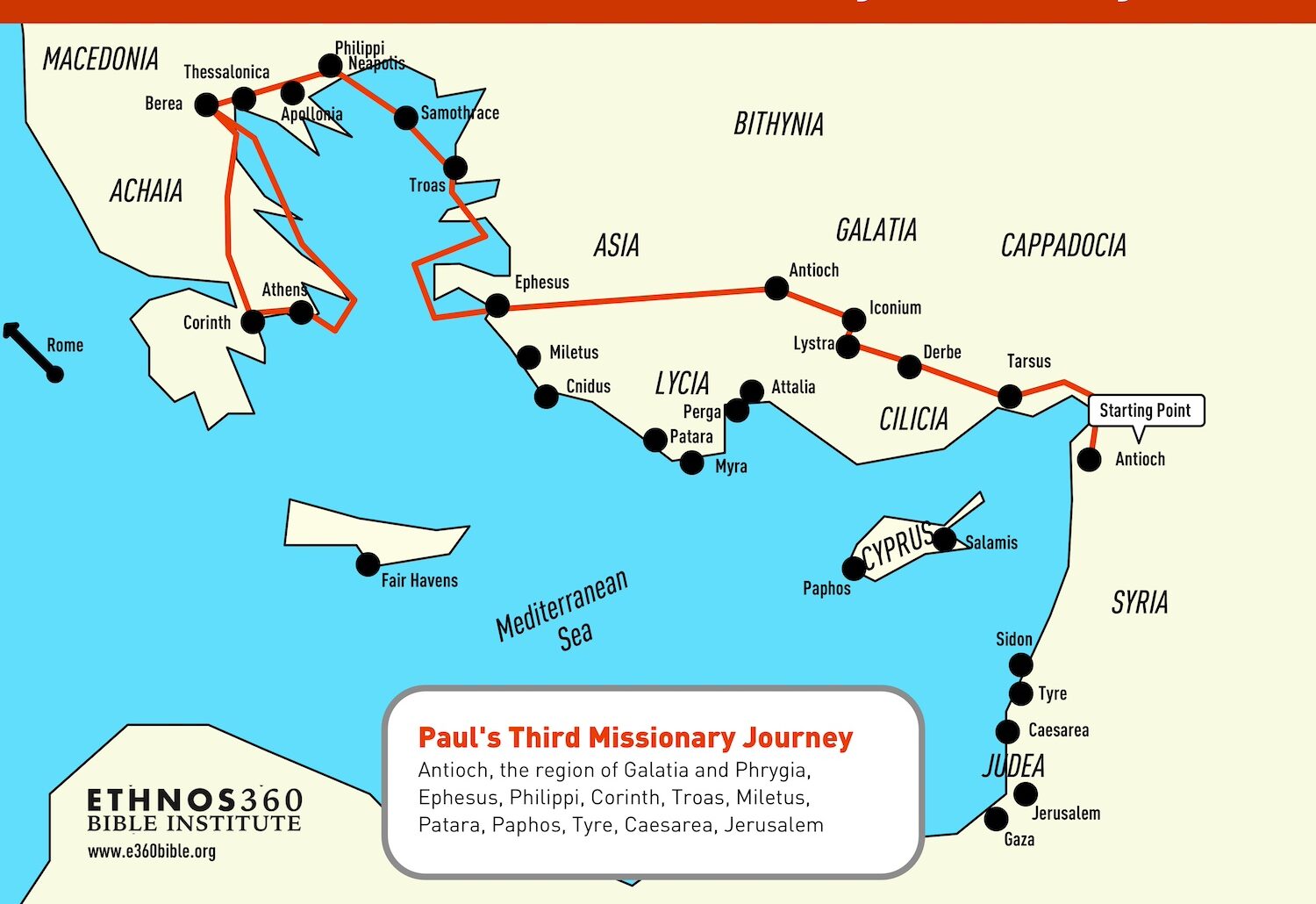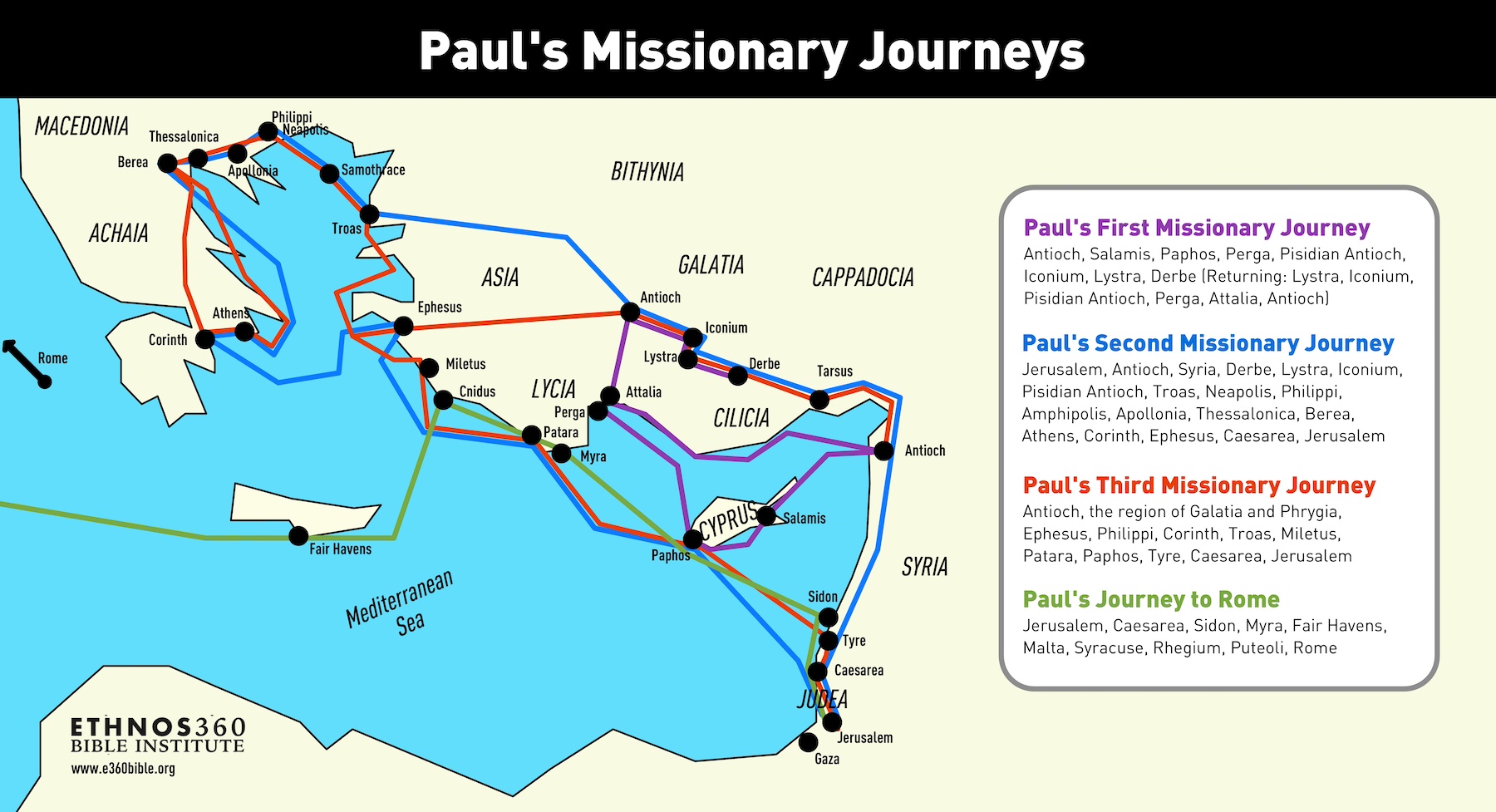
Why is a timeline of Paul’s life and missionary journeys important? Let me tell you! While the Bible is divinely inspired (meaning God wrote it) God used human authors to pen it. By far, the apostle Paul penned the most books. He wrote epistles to churches explaining the gospel and many Christian life truths. Just how many books did Paul write, you ask? Thirteen. Some believe he also wrote Hebrews which would make the total number 14.
Because Paul penned so many books in our New Testament there’s great value to understanding his life and the context he lived in. Within this timeline of Paul’s life and missionary journeys, I’m going to touch on many topics, such as…
- who was the apostle Paul?
- when was he born?
- did he meet Jesus?
- was he a Jew?
- how did his conversion happen?
- was he one of the twelve apostles?
- was he married?
- what books of the Bible did he write?
- how old was he when he died?
- how was he killed?
- what can we learn from Paul’s life?
I’ll also leave you with a list of books and articles about Paul.
Timeline of Paul’s Life and Missionary Journeys (Free Chart)
If you are a more visual learner, this free chart will help you navigate the information below. You can also download your own pdf to keep from the link below.
Timeline of Paul’s Life and Missionary Journeys
(All dates are approximate and most are taken from Kenneth Berding’s website, Kindle Afresh)
9 AD – Paul’s Birth
Paul was from the tribe of Benjamin and born in Tarsus. As was the custom for Jews, his parents had him circumcised on the 8th day. He and Jesus were likely born within the same decade. While it’s possible Paul encountered Jesus before His crucifixion there isn’t scriptural evidence for that. The argument on gotquestions.org for why he may have seen Jesus is that they likely would have visited the same places. Paul also went by the name Saul. The Jews likely referred to him as Saul and the Greeks referred to him as Paul.
20 AD – Paul Studies under Gamaliel
Gamaliel was a teacher of the law of Moses. He was also a member of the Sanhedrin, a group of Jews who made decisions regarding the religious and political lives of the Jews. This training Paul received at a young age was instrumental in him becoming the passionate Pharisee that he was. While we often have negative views of Pharisees, the reality is that they loved God’s word. They were just missing the most important part- that Jesus is the Messiah spoken about in scripture. Needless to say, Paul was deep in the Jewish religion, upholding the traditions and laws. He even claimed to be found blameless and righteous according to the law (Philippians 3:6)!
34 AD – Paul Watches Stephen’s Stoning
At this point, Paul viewed Christians as enemies of God. Stephen was a man known for being faithful and filled with the Holy Spirit. When he was stoned, Paul was there watching. People following Jesus made Paul so angry that he even got a letter from the chief priest giving him permission to chase down believers and harm them. He put many believers (both men and women) in jail for their faith.
34 AD – Paul’s Conversion
That’s right, Paul was converted the same year Stephen was stoned. Acts 9 even uses the phrase, “still breathing threats and murder against the disciples”. Talk about a dramatic conversion! Here’s how it happened. Paul was walking along the road to Damascus when a bright light appeared. Pastor Andy Woods believes that this light was the shekinah glory of God. He says that Paul would have known from scripture that when a light shines down like that, it’s from God. A voice said, “Saul, Saul why are you persecuting me?” When Paul asked who it was the voice replied, “I am Jesus, whom you are persecuting.” Yikes! You can read in Acts 9 to get the rest of the story. It’s in this chapter too that we see God setting Paul apart to preach the gospel to the nations.
34 AD – Paul’s Trip to Damascus
In Damascus Paul spent time in the synagogues (where Jews met) proving that Jesus is the son of God. This left people confused (understandably) by the fact that he was teaching the very message that had angered him before. After several days there, he learned the Jews were plotting to kill him. The disciples helped him escape from them by sticking him in a basket and lowering him through the wall.
34-36 AD- Paul in Arabia
All that we know from scripture about Paul’s time in Arabia is what we find in Galatians 1:15-17 and 2 Corinthians 12:1-4. In Galatians, Paul brings up his trip to Arabia while defending the fact that he got the gospel message he preaches from Jesus Christ. In 2 Corinthians Paul mentions visions and Revelations he received from the Lord. N.T. Wright, in his biography of Paul, draws an interesting comparison between Paul and the Old Testament prophet Elijah. He points out the shared zeal for the Lord they both had. He says it’s likely when Paul went to Arabia he went to Mt. Sinai, a place known for revelations from God. When Elijah left his time with the Lord on Mt. Sinai, he knew he was to anoint a new king. When Paul left Arabia, he knew his mission was to proclaim King Jesus.
36-46 AD – Paul’s Visit to Jerusalem and Time in Tarsus
During his two-week trip to Jerusalem Paul got to know Peter and James a little bit. Being a newer convert, it’s possible he wanted to establish a relationship with the leaders in the church there. From there he went home to Tarsus. Again, scripture doesn’t say much about the time he spent there. Wright speculates that during this time Paul worked as a tentmaker while processing the message he received from God. He had a lot to think about. The scripture he grew up studying made more sense now that he knew it pointed to Christ.
Paul’s Missionary Journeys (Free Map)
If you are a more visual learner, this free chart will help you navigate Paul’s travels. You can also download your own pdf to keep from the link below.
47-48 AD – Paul’s First Missionary Journey
 The church in Antioch sent Paul and Barnabas out on their first missionary journey. John Mark went along with them as well. The first place they preached was the island of Cyprus. There they made a stop at a Jewish synagogue in the city of Salamis. After traveling throughout the island, they met a Jewish sorcerer in another city called Paphos. The sorcerer tried to turn the officer he worked for away from Paul and the faith. Paul responded to him, “You are a child of the devil!” and told him that he’d become blind. And so, it happened. As a result of that, and the teaching about the Lord, the officer believed.
The church in Antioch sent Paul and Barnabas out on their first missionary journey. John Mark went along with them as well. The first place they preached was the island of Cyprus. There they made a stop at a Jewish synagogue in the city of Salamis. After traveling throughout the island, they met a Jewish sorcerer in another city called Paphos. The sorcerer tried to turn the officer he worked for away from Paul and the faith. Paul responded to him, “You are a child of the devil!” and told him that he’d become blind. And so, it happened. As a result of that, and the teaching about the Lord, the officer believed.
After their time in Cyprus, they sailed along to Perga. While there, John Mark left them and went back to Jerusalem. We don’t know why he left, but we do know from Acts 15:38 that Paul considered it a fault. He didn’t want John Mark to travel with them the next time it was suggested. Much later though, in 2 Timothy 4:11, we see there must have been some reconciliation. Paul asks for Mark to come to him saying he is “useful for me in ministry”.
The next stop Paul and Barnabas made was Pisidian Antioch. There in a synagogue, he walked the Jews through their history and pointed to Christ. The Jews’ jealousy was sparked by this. Paul announced to them that he would turn to the Gentiles. ‘Jews then Gentiles’ is a pattern he continued to follow in each town he went to. Another pattern you’ll see is persecution and abuse at the hands of the Jews. Once that abuse happened here, Paul and Barnabas left. They headed from there to Iconium, Lystra, and Derbe- three cities in the region of Galatia.
In Iconium, the Lord proved their message of grace was true by allowing them to perform miracles. Some of the people there agreed with Paul, and some didn’t. A group of Gentiles and Jews who didn’t agree planned to stone them. When the apostles learned of it, they escaped yet continued to preach the gospel.
After healing a lame man in Lystra, the people thought Paul and Barnabas were gods and tried to worship them. The apostles were quick to tell the people they were only human. They explained that they had come to tell the people to turn from worthless things and instead turn to the living God. Being swayed by Jews, the crowd went from worshipping them to stoning Paul. They even dragged him outside of the city once they thought he was dead. When the disciples came to Paul, he stood up and went right back into the city.
The next day Paul and Barnabas continued to Derbe. There they preached the gospel, and many believed. Afterwards, they went back through Lystra, Iconium, and Pisidian Antioch. In each place, they appointed elders for the churches and encouraged the believers. From there they preached in Perga then sailed out of Attalia, back to Antioch. When they arrived in Antioch, they praised the Lord for the work He helped them complete. They told the church what they had done and how God had opened the door wide to Gentiles!
49 AD – Jerusalem Council
After his first missionary journey Paul wrote Galatians. It was likely his first epistle. Remember how Paul went to Iconium, Lystra, and Derbe? Those are all in Galatia. While he was there, he planted the churches he writes to in Galatians. He wrote the letter to defend the gospel. It was a response to a message that was being spread by false teachers. The teachers were trying to add Jewish traditions to the Galatians’ Christianity. They were also saying that the religion Paul preached was man-made. People tended to question Paul since he was not one of the twelve apostles. So Paul reminded the Galatians that he received this message of grace directly from Christ.
Later, Paul and Barnabas met with church leaders in Jerusalem to discuss a matter they were concerned over. There were people requiring the circumcision of gentile believers. Paul didn’t think extra requirements and Jewish traditions, such as circumcision, should be put on the Gentiles. He wanted to make sure the Jerusalem church was on the same page as him. By the time the meeting ended, the church and Paul were in agreement.
49-52 AD Paul’s Second Missionary Journey
 From Jerusalem, Paul and Barnabas went up to Antioch with a group of men. There they delivered a message about the decision made at the Jerusalem Council. Paul and Barnabas stayed longer than the other men and preached the Word. After some time, Paul suggested traveling to visit the believers in the towns they had already been to. Barnabas wanted to bring John Mark along, but Paul refused saying that John Mark had deserted them. The conflict was so big that it caused Barnabas to part ways with Paul. Silas went along with Paul instead.
From Jerusalem, Paul and Barnabas went up to Antioch with a group of men. There they delivered a message about the decision made at the Jerusalem Council. Paul and Barnabas stayed longer than the other men and preached the Word. After some time, Paul suggested traveling to visit the believers in the towns they had already been to. Barnabas wanted to bring John Mark along, but Paul refused saying that John Mark had deserted them. The conflict was so big that it caused Barnabas to part ways with Paul. Silas went along with Paul instead.
Silas and Paul strengthened believers in Syria and Cilicia. After going to Derbe they met Timothy in Lystra. Timothy was a young believer from Jewish and Greek heritage. Other believers spoke well of him. Because of this, Paul decided to take Timothy along. He had him circumcised for the sake of the Jews in the area they were trying to reach.
After a while, they traveled through the regions of Galatia and Phrygia. From those regions, they went to a town called Troas. While in Troas, Paul had a vision of a man in Macedonia asking for help. In response, he headed over there immediately. One of the first stops made in Macedonia was Philippi.
While in Philippi, some men had Paul and Silas arrested. This was a result of Paul casting a spirit out of a slave girl. Her owners were angered by this because they had been making money off her. After a short time in jail, the city officials asked Paul and Silas to leave the city. But they didn’t. Instead, they went to the home of a woman named Lydia. There they encouraged the believers, before leaving town.
When they stopped in Thessalonica, Paul preached in the synagogue for three weeks. Many believed including Jews and Greeks. At the end of the three weeks, jealous Jews rounded up a mob and started a riot. Once again Paul (and Silas), snuck away during the night.
The next stop was Berea. As they always did, they began in the Jewish Synagogue. The Berean Jews checked what Paul was saying against scripture and many came to believe. Unfortunately, the Jews from Thessalonica caught up to them and chased Paul out again. Silas and Timothy stayed in Berea a bit longer, possibly to continue encouraging the new believers, while Paul went to Athens.
In Athens, Paul saw many idols. There was even an altar to “An Unknown God”. Because the Athenians were into so many gods they were more open to hearing what Paul had to say. He reasoned in public there with both Jews and Gentiles. Some were confused and thought he was teaching a foreign religion. When Paul spoke in the Areopagus, a meeting place, he told them of the superiority of God, the creator of everything, compared to the unknown gods and objects they worshipped. He also talked about Christ’s resurrection, which the philosophers had problems with. As a result though, some did come to believe.
From Athens, Paul went to Corinth. He found there another tentmaking Jew named Aquila, and his wife Priscilla. They invited him to stay with them, so he did. After some time, Silas and Timothy caught up in Athens. They were able to bring with them a good report about the Thessalonian believers. It was then that Paul wrote 1 Thessalonians. Only a few months later he wrote a follow-up letter, 2 Thessalonians. Now that he had his friends’ help in Corinth, he devoted himself to testifying to the Jews that Jesus is the Messiah.
‘But when they opposed Paul and became abusive, he shook out his clothes in protest and said to them, “Your blood be on your own heads! I am innocent of it. From now on I will go to the Gentiles.” ‘ Acts 18:6
Paul went right next door to the house of Titius Justus and preached there. Many believed and were baptized including a synagogue leader. The Lord comforted Paul in a vision. He encouraged him to keep speaking and told him that nobody would harm him. Paul’s total stay in Corinth was over a year and a half. When he left, Priscilla and Aquila sailed with him.
Paul, Priscilla, and Aquila went to Ephesus. There Paul went into the synagogue and spoke to the Jews. Priscilla and Aquila stayed behind there in Ephesus when Paul left for Caesarea and Jerusalem.
52-57 AD – Paul’s Third Missionary Journey
 Paul went on yet another missionary journey. His goal was to spend his time encouraging the believers. He paid yet another visit to the believers in Galatia and Phrygia then went to the port city of Ephesus.
Paul went on yet another missionary journey. His goal was to spend his time encouraging the believers. He paid yet another visit to the believers in Galatia and Phrygia then went to the port city of Ephesus.
In Ephesus, Paul spoke for three months in the synagogue. Many of the people there were stubborn. Because of that Paul took the disciples with him and spoke somewhere else in Ephesus. They spent two more years there. Acts says that all the Jews and Greeks in the province of Asia heard the word of the Lord. And by the Lord’s strength, many miracles were done. Paul sent Timothy and Erastus to Macedonia while he stayed longer.
Towards the end of his stay in Ephesus Paul wrote 1 Corinthians. He wrote in response to a report he had heard about the new church. He knew he needed to address several topics the church there was having issues with. The topics were community, sex, food laws, church gatherings, and the resurrection. He also gave them instructions on marriage. Paul was not married so he pointed out the value of singleness. He says in singleness it’s easier to focus on the Lord and the Lord’s work. But he also says that being married is not a sin and is the better option if you can’t control your passions.
While still in Ephesus, a silversmith stirred up trouble. Because of the message Paul shared people were no longer buying the idols he made. While the city was in an uproar over this, Paul wanted to appear before them all. His friends begged him to stay away from the chaos.
When it was over, Paul went to Macedonia and encouraged the believers there. While there, he wrote 2 Corinthians. It was an attempt to mend his relationship with them after the hard letter he’d written before. He also wanted to prepare them for a visit. From there he went down to Greece and paid a checkup visit to the Corinthian church. It was there that he wrote his letter to the Romans.
Paul had planned to sail to Syria, but because of a plot against him changed his mind. The way he traveled back instead was through Macedonia. In Troas, Paul raised a young man from the dead. When he passed through Miletus, he had the Ephesian elders come to him. Goodbyes were said, because he didn’t know what might happen to him when he got back to Jerusalem.
From there Paul sailed to Kos, Rhodes, and Patara then boarded a ship that crossed over to Phoenicia. When the ship stopped in Tyre, he spent time with the disciples there. Many of them told Paul not to go to Jerusalem. They all prayed together, and Paul continued on. In Ptolemais and Caesarea, he greeted the believers. A prophet prophesied that Paul would be bound by Jewish leaders and handed over to Gentiles when he reached Jerusalem. Again, many pleaded for Paul not to go. He stated in response that he was willing to die for Jesus.
57 AD – Paul’s Arrest in Jerusalem
When Paul got to Jerusalem the believers welcomed him. At that time, Jerusalem was in an economic depression and the church was being persecuted. Because of that, Paul had been collecting a gift of money for them and was finally able to give it. He also shared with them what the Lord had done on his journey, and the people responded with praise.
Jews in Jerusalem heard rumors about Paul and weren’t happy about them. James advised Paul to bring sacrifices to the temple. The hope was, that the Jews would see this and know he was Godly. It was also to show that what they heard wasn’t true. While he was in the temple, a whole crowd gathered and tried to kill him. The commander of the Roman troops made them stop and arrested Paul. Paul shared his testimony and defense there before the people who had tried to kill him. The crowd became enraged when Paul got to the part about the Lord sending him to the Gentiles. When Paul shared that he was a Roman citizen the commander decided to investigate further.
The next day, the commander had Paul stand before the whole Sanhedrin. The Jews were once again angered by what Paul said, and the commander had his troops take Paul back to the barracks. While there, the Lord told Paul to take courage and that he would also testify in Rome. Forty Jews plotted to kill Paul along the journey. When the commander heard about it, he had Paul transferred to the governor with 470 guards for protection along the way to Caesarea.
In Caesarea, the high priest, Ananias, and his lawyer, brought charges against him. Felix, the governor, left Paul in prison for two years hoping he would offer a bribe. After two years, a new governor, named Festus, took over. Again, the Jewish leaders brought charges against Paul and again they tried to have him killed. Paul appealed to Caesar. Before he went to Caesar, he also shared his testimony in front of a visiting king named Agrippa. Agrippa, his wife, and Festus all agreed that Paul was innocent, but because he had appealed to Caesar that’s where he needed to go instead of being released.
59-62 AD – Paul’s Trip to Rome and House Arrest
Paul set sail for Rome along with some other prisoners. When they made a stop in Sidon, the head officer was gracious and allowed Paul to visit his friends there. From there they traveled in a few different boats. At one point, storms were so bad that their ship wrecked. Paul said the Lord told him they would all survive. As the Lord promised, they were all able to make it to the island of Malta. There the islanders cared for them. By a miracle, Paul survived what could have been a deadly snake bite. He also cured many people on the island. Months later, they finally made it to Rome.
In Rome, they allowed Paul to live under house arrest for two years. While under house arrest, he preached to Jewish leaders. Even while under arrest, Paul continued to proclaim the kingdom of God. He also wrote epistles while he was there- Ephesians, Philippians, Colossians, and Philemon.
62-64 AD – Paul is Released
After two years, Paul was released. We know little about this period of Paul’s life since Acts ends with him under house arrest. Swindoll points out on Insight.org that Paul seemed confident of his coming release in Philippians 2:24. It seems that sometime after his release he wrote 1 Timothy and Titus. These are the first of his Pastoral epistles.
65 AD – Paul’s Final Imprisonment and Death
There isn’t scripture for it, but it’s commonly believed that once again Paul was imprisoned in Rome, this time under Nero’s rule. There he wrote his final epistle, 2 Timothy. The tone of this pastoral epistle is extremely heartfelt since Paul realized his end was near. He was most likely beheaded at the age of 56.
What We Can Learn from the Apostle Paul’s Life
Here are just a few lessons that stood out to me in this timeline of Paul’s life and missionary journeys.
Nobody is too far gone to put their trust in the Lord and serve Him. Paul was ‘breathing threats and murders against Christians’, and then he was saved.
Traditions and feasts are not the important thing. Before Christ, Paul kept the traditions perfectly. After Christ, he writes that these traditions were only a shadow of what was to come. Christ is the reality, and we become righteous in him, not in things that we do (see 2 Corinthians 5:21).
The Old Testament is still important and points to Christ. When Paul taught, he usually started with the Old Testament. He especially did this while teaching in synagogues. His epistles also included many Old Testament quotes.
We can learn from Paul’s writings. In his epistles, Paul unpacks many topics related to the gospel and Christian life. He addresses real-life issues the early church had that are still relevant today. It’s in his epistles that we also find what the church should look like and what its purpose is.
Serving the Lord is worth the cost. Paul said, “To live is Christ, to die is gain.” We see this lived out in his life. He put himself in dangerous situations for the sake of the gospel.
Discipleship is important. Paul didn’t only evangelize. He circled back to the new believers and encouraged them in their walk with the Lord. He wrote them letters to help them grow and visited them when he could. Sharing the gospel with unbelievers is important. Walking alongside them after they’re saved is also important.
Paul’s Epistles in Chronological Order
This order is approximate. Each epistle title links to an overview of the background, author, themes and audience.
- Galatians
- 1 Thessalonians
- 2 Thessalonians
- 1 Corinthians
- 2 Corinthians
- Romans
- Ephesians
- Philippians
- Colossians
- Philemon
- 1 Timothy
- Titus
- 2 Timothy
Books and Resources for Further Study on the Apostle Paul
I used these resources to compile this timeline of Paul’s life and missionary journeys.
Books
Paul: A Biography by N.T. Wright
This book is easy to read and holds a lot of valuable information about the events I mentioned in this timeline of Paul’s life and missionary journeys.
A Harmony of the Life of St. Paul by Frank J. Goodwin
This book was helpful in creating a timeline of Paul’s life and missionary journeys. It takes scripture about Paul as well as his writings and rearranges it in a chronological order.
Articles and Videos
Eyewitness Account Videos about Missionary Journeys
In this video series actors act as different people involved in the timeline of Paul’s life and missionary journeys (Barnabas, Timothy, etc.) . They tell stories of Paul from ‘their’ perspectives.
“How did the Apostle Paul die?” answered on Christianity.com
Chronology of the Apostle Paul on Kindle Afresh
1 Timothy on Insight for Living
Interested in digging deeper into God’s word?
Does understanding the context of scripture interest you? Here at Ethnos360 Bible Institute, we walk students through the Bible exegetically and chronologically. We dig into the background and find application using careful hermeneutics. Our teachers care deeply about our students. They’re always willing to discuss the Bible and Christian life topics with them. If this interests you, request a free info packet below!





What about hebrees
It’s true that many people believe Hebrews was written by Paul and it very well could have been. I chose not to include it here because it isn’t clearly stated.